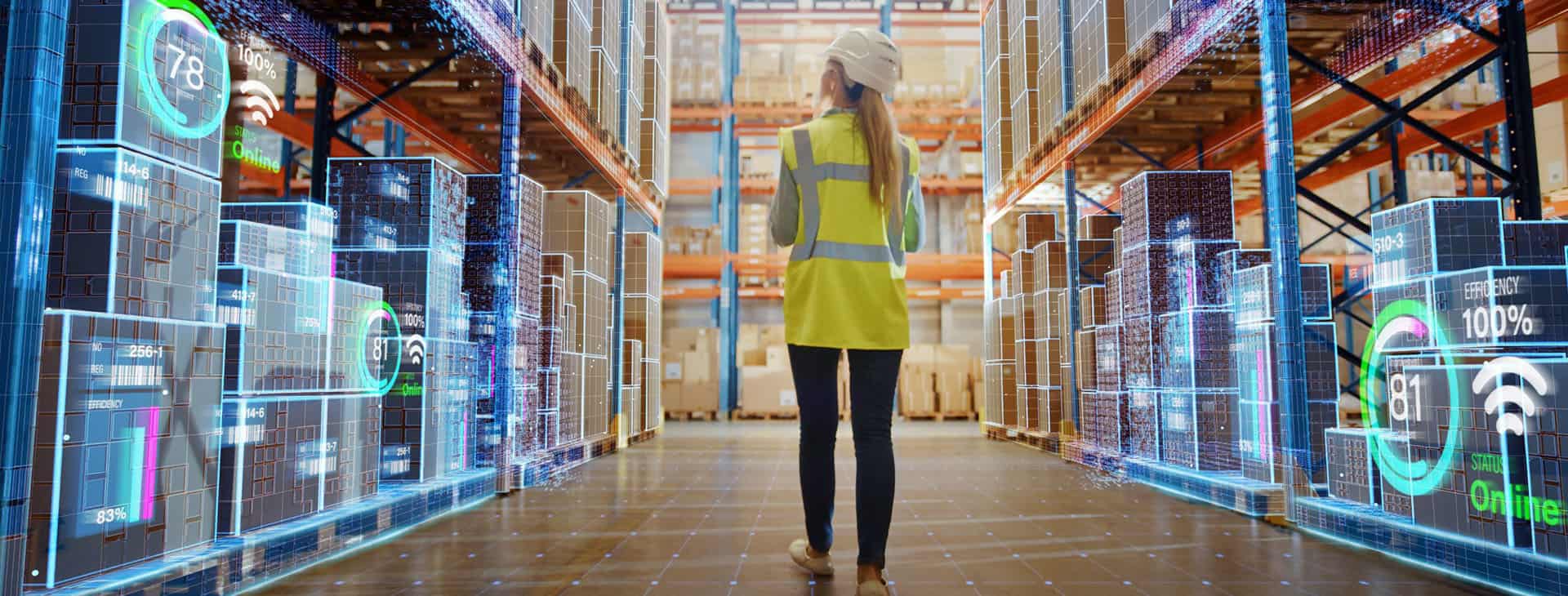The innovations characteristic of the industrie 4.0
Artificial intelligence (AI) is a process of imitating human intelligence based on the creation and application of algorithms executed in a dynamic computer environment. Its goal is to enable computers to think and act like human beings.
AI is an essential tool for Industry 4.0. By using intelligent software solutions, large volumes of data can be used to identify trends and patterns that can increase the efficiency of production processes and reduce their energy consumption. As a result, industries are continuously adapted to new conditions and optimised without operator intervention. And as the level of interconnectedness increases, the AI software can learn to read “between the lines,” enabling the discovery of many complex interrelationships that humans would not or no longer be able to grasp.
According to an article published by the Tech company Seebo, the use of Artificial Intelligence for manufacturing can be classified in 5 elements: 1) predictive quality and yield, which supervises the production and allows manufacturers to know which are the causes for production losses, 2) predictive maintenance, which uses algorithms to prevent the failure of a system or a machine and warns the personnel in advance so that they can find a solution before the damage happens, 3) robots assisting humans in the production, which due to AI can be given increasing responsibility as they learn by, 4) generative designs, using algorithms to help manufacturers in producing new designs, and 5) the adaptation to the market, by bringing the possibility of predicting demand (Seebo, 2018).
Internet of Things (or IoT) is the term used describing the connection of devices to the internet, as well as having the possibility to communicate with each other. Thanks to sensors in the machines, or through the use of robots and autonomous machines, a constant flow of information is created, which helps to adjust production, prevent possible defects or detect the stages where production can be improved.
Broadly speaking, cyber-physical systems (CPS) are devices controlled by calculations and algorithms. These devices are monitored by computers that control the physical processes (TechNative, 2020). However, the key is in the feedback, thanks to which the system interprets the actions, traces the results and learns automatically to improve the performance.
Big Data is the collection of data from traditional and digital sources that occurs on a continuous basis. This huge amount of data is an extremely valuable source of information, which must be analysed in real time in order to draw conclusions that allow industries to be more efficient.
3D printers play a very important role in the Industrie 4.0. Although they have existed since the 1980’s, they have only started to become truly workable and affordable in the last decade. 3D printing has now revolutionised the industrial sector. One of the main uses is to prototype products in a faster and more cost effective way. It shortens production times and facilitates the detection of design errors that can be resolved more quickly. In recent years, innovations in 3D printing have caused a radical change in the manufacture of all types of products.
All these factors result in a smart and adaptable production. They are based on the fact that machines are connected to each other and to the Internet thanks to, among others, ubiquitous sensors, which allow for optimised processes of production.
Process of implementation
The industry 4.0 covers processes aimed at making factories “intelligent” through the internet, allowing all elements of the production process to be interconnected. Whereas the third industrial revolution was already based on the integration of automated processes, the Fourth Industrial Revolution reuses those elements and takes them significantly further. Its goal is to create intelligent factories, which can adapt more easily to the needs and processes of production. Until now, industrial processes required very extensive planning, in addition to considerable delays or losses if production had to be stopped in case of failure. The technological improvements linked to the Industrie 4.0 allows for a complete transformation of the chain of productions. For example, the use of sensors in machines allow manufacturers to prevent anomalies and damages before they happen. This way, a solution can be found faster, avoiding slowing down production and downtime.
Historically, the industry was focused on the industrialization of near-identical products (figure 1). It is now in full mutation in order to respond to a customer demand for customised products. However, with the fourth industrial revolution, the extent of the evolution is more significant. Moving from mass production to the production of unique objects in small quantities (individualization, see figure 1) requires a strong reorganisation of the production means.
This paradigm shift towards individual production has been predicted long before the “fourth industrial revolution”, and it is now becoming concrete. If the gains obtained by the industrie 4.0 prove to be significant by individualising while lowering the costs drastically, it will be different from a simple technological evolution, it will indeed be a revolution, although the changes will likely be gradual and the “revolutionary” aspect of Industry 4.0 will therefore be observable later on, as the societal (restructuration of the labour market mentioned earlier) as well as energetic and environmental (energy saving and lowering pollution) impacts it will generate will be observable.
Figure 1: Volume of production and variety in four manufacturing paradigms over time

Source: Koren, 2021
Figure 2: Steps on how to implement Industry 4.0

Source: Dataintel, n.d.
According to the Danish Engineering company Data Intelligence (figure 2), the steps needed in order to implement the Industrie 4.0 in a manufacture are as following:
- Data collection: being able to collect data from machines is essential for manufacturers in order to later on analyse it. The collection of data can be achieved through sensors, connected to the Internet of Things, and allow the manufacturer to observe, for example, why two identical machines have different results.
- Digital process: this consists in digitising the production processes, which allows for a facilitated production management, as the data collected through sensors can be analysed.
- Predictive maintenance: this step is based on the two preceding ones, as it cannot be achieved without installing sensors for collecting data and digitising them. Once they have been achieved, this step consists in analysing the data produced in order to be able to prevent breakdowns or damages.
- Self-adjusting machines: this step consists in making the different machines of the production process “communicate” with each other, which allow them to inform other machines of critical elements such as what causes risks of breakdown, even in different countries and instantly, due to the rapidity of the Internet of Things.
The central progress: digitalisation
In a manufacture that has been transformed and adapted to the Industrie 4.0, digitalisation is present all the way throughout the production chain: product design (for example with virtual factories), control and management (automation of flows, and factory lines connected to the Internet of Things and even automated logistics), and manufacturing processes (with the help of robots). This allows for very important money savings. Indeed, as seen on figure 3, the productivity index established by the OECD grows significantly more over time in high digital intensity industries than in low digital intensity ones. Moreover, the replacement of repetitive and dangerous jobs by machines and thus the focusing of the labour force on higher value-creating activities.
Figure 3: Productivity index of OECD countries’ industries with high and low digital intensity

Source: OECD, 2017
During the first three industrial revolutions, the worker underwent the transformations of industry (replacement by machines, loss of employment) while seeing long-term benefits for the industrial sector (increased productivity which leads to lower production costs and therefore lower prices for goods). Unlike previous revolutions, the worker is already ahead of his company. Indeed, the use of smartphones with multiple uses and the acquisition of connected objects have allowed a large part of the population to apprehend this transformation ahead of time. The transition to Industry 4.0 is therefore better understood by workers, as they are already generally “connected”, even before their company in many cases.
The Acatech Industrie 4.0 Maturity Index was designed to identify the different stages through which companies needed to go in order to fully transform to the Industrie 4.0 model. The first stage is computerisation, since it is needed in the first place in order for a company to be able to digitalise. The second stage is connectivity, which consists in bringing detached components of the production line together and making them linked to each other. The third stage is visibility, which requires sensors in order to be able to record various elements like temperature or events in order to give an up-to-date overview of the production line’s functioning. The fourth stage is transparency, which implies recording all relevant elements detected by sensors in order to use them for introspection and therefore to prevent future problems. The fifth stage is predictive capacity, which is based on accumulating data and linking it to other information, in order to be able to predict future behaviours and scenarios, helping manufacturers to anticipate future developments and allowing them to react the best way possible. The last stage is Adaptability, which bases itself on the 3 previous stages in order to allow companies to use all the collected data, sometimes delegating it to IT companies, in order to achieve the atomisation of the decision taking in function of past events.
Figure 4: Implementation challenges for overall implementation of Industrie 4.0 technologies

Source: (Bajic, et al. 2020).
Although companies’ lack of funds for modernization of their material is a major setback, the barriers preventing entrepreneurs from achieving their transition towards Industrie 4.0 are not only financial or technical. Various entrepreneur-level factors also delay this technology adoption. As seen on figure 4, the technical challenges such as financial resources or data issues are very frequent, but so are issues such as human resources and strategy challenges.
Entrepreneurs’ reluctance towards the Industrie 4.0 can have various origins. A frequent motive for reluctance can be because of the “lack of trust with second parties” (Bajic et al., 2020), which refers to entrepreneurs’ unwillingness to share their information with second parties, which is an essential step for the transition. Moreover, manufacturing companies’ defiance can originate from an uncertainty concerning returns on investment (Bajic et al., 2020), referring to the perceived risk that the costly technological transition needed will not be profitable. Manufacturing companies’ reluctance generally originates from the lack of knowledge about the Industrie 4.0. They frequently either ignore this evolution due to the perception of an overwhelming and time-consuming amount of changes needed to do the transition, or in some cases pragmatically deduct that they will not be able to achieve it, for instance because of a lack of transition strategy or material for schooling their managers to implement those changes (Bajic et al., 2020).
In many cases, entrepreneurs are simply unaware of the existence of the fourth industrial revolution, since it is still a very new concept. Frequently, manufacturers are not “up to date” when it comes to the industry 4.0 and the technological improvements linked to it, or more generally to modern technologies (Bajic et al., 2020). SMEs’ lack of awareness concerning the Industrie 4.0 and its technological evolutions is such a widely spread problem that governments of countries like Poland defined it as one of the major barriers to the implementation of the Industrie 4.0, being on similar levels of priority as the financial barriers.
References:
B. Bajic, A. Rikalovic, N. Suzic and V. Piuri, “Industry 4.0 Implementation Challenges and Opportunities: A Managerial Perspective,” in IEEE Systems Journal, vol. 15, no. 1, pp. 546-559, March 2021, doi: 10.1109/JSYST.2020.3023041.
How the Precision of Process-Based Machine Learning Solves Manufacturing Disruptions. Seebo, December 2018. Available at: https://blog.seebo.com/process-based-machine-learning/
Cyber-Physical Systems – The new and emerging systems of intelligence. Technative, January 2020. Available at: https://technative.io/cyber-physical-systems-the-new-and-emerging-systems-of-intelligence/





